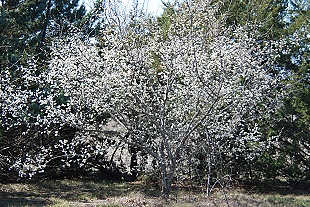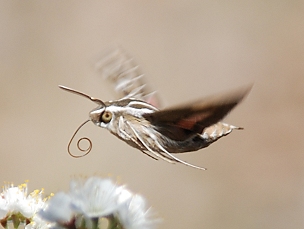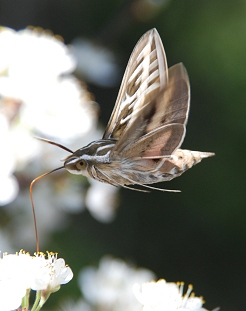Mexican plum, the tree-sized wild plum around here, blooms even in drought years. Not only is it snowy white and beautiful, it has that amazing wild-plum fragrance…and as it’s an early bloomer, it attracts everything that’s hungry for nectar.

Mexican Plum in full bloom
It doesn’t look like this long–especially in a drought year–and the tiny white petals are already blowing off it in today’s stiff warm breeze.
This tree is covered with honeybees, but they’re not the only nectar-seekers. The pretty little Grapevine Epimenis moth was there, but between the wind and the moth’s bouncing from flower to flowe, we’re stuck with last year’s image of it. Among the butterflies, Red Admirals, Common Buckeyes, Variegated Fritillaries, and various Sulphurs (including Lyside Sulphur) are also common visitors to wild plum.
Less common in the middle of the day is the White-lined Sphinx Moth, Hyles lineata, but today one was busily working the flowers while I was trying (unsuccessfully) to get a good shot of the others.

Which flower to plunder?
Once it’s committed, the moth spends but a second or two at each of the tiny plum flowers. You can see they’re not good pollinators for these flowers, as they hover well above the stamens. Some flowers have longer stamens and hide their nectar deeper in the flower.

Sphinx moth sipping nectar
These moths are often mistaken for hummingbirds from a distance–they’re big and they hover, hummingbird-like. I’ve also seen and photographed the Snowberry Clearwing Moth working plum flowers, but those were the thicketing plums, that bloom a few weeks later.
Comment by Susan Froebel — February 26, 2009 @ 2:54 pm
Inspired by the trees I’ve seen blooming the last few days, I was telling a coworker about the walk we took on your place during your birthday party and the plum tree, perhaps this very one, that was completely covered with tiny little butterflies so that it looked like it was shimmering in the sun.
Happy birthday to you, early, I think, but I didn’t want to forget. Since I was thinking of you, now seemed a good time.
Comment by cdozo — February 26, 2009 @ 4:17 pm
Those sphinx moth photos are amazing!
Also, for the first time I know what many of the things you name in this post look like without looking them up. This is due, in large part, to your patient tutoring, loaning of books and posting of photos.
Thanks.
Comment by elizabeth — February 26, 2009 @ 4:26 pm
I was so lucky to get those good shots. Those are, as you know, fast-flying, agile moths that dart around a lot and I had to use manual focus to get the moth in focus shooting between branches and twigs–most of the time I’d just get *almost* focused and the moth would dart away. But sometimes, if you shoot enough frames, one comes out.
Comment by elizabeth — February 26, 2009 @ 4:27 pm
I think that may’ve been a different tree, farther out on the land–but I do remember the year it was butterfly-decorated.
It’s early, but thank you! Yes, the plums are blooming earlier than other years–it’s been creeping up.
Comment by gunhilda — February 26, 2009 @ 7:07 pm
Wow! Those are fabulous pictures of the moth! I haven’t been able to get a good side photo at all. Was your guy out during the day? I only see them in the evening, near dusk.
http://i7.photobucket.com/albums/y293/gunhilda/Yard%20Pics%202008/DSC04011-1.jpg
http://i7.photobucket.com/albums/y293/gunhilda/Yard%20Pics%202008/DSC04012-1.jpg
http://i7.photobucket.com/albums/y293/gunhilda/Yard%20Pics%202008/DSC04040.jpg
Comment by Nancy — February 26, 2009 @ 7:49 pm
Beautiful photos of a beautiful moth!
Comment by elizabeth — February 26, 2009 @ 8:03 pm
These shots were taken right around noon–I was surprised to see this moth out in broad daylight, because I also usually see them near dusk, often at pink evening primrose flowers.
But it’s a drought year, very very dry, and there’s not much else blooming–no evening primroses, for instance.
Another interesting thing–the Grapevine Epimenis moth usually goes higher in the tree (at least head-high on me, often is right up at the top of the flowers) and the other butterflies also tend to use the upper half of the tree. This moth stayed lower, in the bottom third of the tree, for the time I was observing it (which wasn’t that long, admittedly. Hot day, hot sun, and the need to get back to other work…)
Comment by elizabeth — February 27, 2009 @ 6:05 pm
I can’t make my reply comments “stick” to the comments I’m replying to, but gunhilda’s moth pictures are gorgeous–any of you who haven’t looked at those links…do so.
Hers show the pink that’s on the upper wing (and my shutter speed wasn’t fast enough to stop the wings and show it–also my angles were wrong.)
Comment by ForestWander Nature Photography — February 27, 2009 @ 7:28 pm
What an awesome picture of a moth.
That is great.
Is that its eye or is it just the markings?
Comment by elizabeth — February 27, 2009 @ 10:32 pm
It is the eye, though it’s hard to believe it’s a compound eye, isn’t it? I’ve found that damselfly eyes also look like an iris-and-pupil arrangement. For instance, this one:
http://pics.livejournal.com/e_moon60/pic/0004yhz3/g41
I have another moth picture with a “staring” eye:
http://pics.livejournal.com/e_moon60/pic/0002rx93/g16